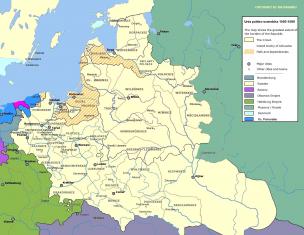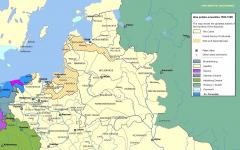_________________
* Taking into account the use of one lane for parking cars.
Notes*: 1. The width of streets and roads is determined by calculation depending on the intensity of traffic and pedestrians, the composition of elements placed within the transverse profile (roadways, technical lanes for laying underground communications, sidewalks, green spaces, etc.), taking into account sanitary -hygienic requirements and civil defense requirements. As a rule, the width of streets and roads in red lines is taken, m: main roads - 50-75; main streets - 40-80; streets and local roads - 15-25.
2*. In conditions of complex terrain or reconstruction, as well as in areas with high urban planning value of the territory, it is allowed to reduce the design speed for express roads and streets of continuous traffic by 10 km/h with a decrease in the radii of curves in the plan and an increase in longitudinal slopes.
3. For the movement of buses and trolleybuses on main streets and roads in large, large and largest cities an edge strip 4 m wide should be provided; For the passage of buses during peak hours at an intensity of more than 40 units/hour, and in conditions of reconstruction - more than 20 units/hour, a separate roadway 8-12 m wide is allowed.
On main roads with the predominant traffic of trucks, it is allowed to increase the width of the traffic lane to 4 m.
4. In climatic subregions IA, IB and IG, the greatest longitudinal slopes of the roadway of main streets and roads should be reduced by 10%. In areas with a winter snowfall volume of more than 600 m/m, strips up to 3 m wide should be provided within the carriageway of streets and roads for snow storage.
5. The width of the pedestrian part of sidewalks and paths does not include the areas required to accommodate kiosks, benches, etc.
6. In climatic subregions IA, IB and IG, in areas with snowfall volumes of more than 200 m/m, the width of sidewalks on main streets should be at least 3 m.
7. In conditions of reconstruction on local streets, as well as during the design pedestrian traffic less than 50 people/hour in both directions, sidewalks and paths 1 m wide are allowed.
8. When sidewalks directly adjoin the walls of buildings, retaining walls or fences, their width should be increased by at least 0.5 m.
9. It is allowed to provide for the gradual achievement of the design parameters of main streets and roads, transport intersections, taking into account the specific volumes of traffic and pedestrians, with the mandatory reservation of territory and underground space for future construction.
10. In small, medium and big cities, as well as in conditions of reconstruction and when organizing one-way traffic, it is allowed to use the parameters of main streets of district significance to design main streets of citywide significance.
2.6. When designing a residential development, as a rule, there are two main levels structural organization residential area:
Microdistrict (quarter) is a structural element of residential development with an area of usually 10 - 60 hectares, but not more than 80 hectares, not dissected by main streets and roads, within which institutions and enterprises of everyday use are located with a service radius of no more than 500 m (except schools and preschool institutions, the service radius of which is determined in accordance with Table 5 of these standards); boundaries, as a rule, are main or residential streets, driveways, pedestrian paths, natural boundaries;
A residential area is a structural element of a residential area, usually ranging from 80 to 250 hectares, within which institutions and enterprises with a service radius of no more than 1500 m are located, as well as some objects of urban importance; Borders, as a rule, are difficult to cross natural and artificial boundaries, main streets and roads of citywide importance.
Notes:
1. A residential area is, as a rule, the subject of a detailed planning project, and a microdistrict (quarter) is a development project. The designed object should be assigned to one of the levels of the structural organization of the residential area in the design assignment.
2. In small towns and rural settlements with a compact planning structure, the entire residential area can be a residential area.
3. In the historical development zone, the elements of the structural organization of the residential area are blocks, groups of blocks, ensembles of streets and squares.
2.7. The number of storeys of a residential building is determined on the basis of technical and economic calculations, taking into account architectural, compositional, social, hygienic, demographic requirements, features of the social base and the level of engineering equipment. Note. For cities located in areas with seismicity of 7 - 9 points, as a rule, one- and two-section residential buildings with a height of no more than 4 floors, as well as low-rise buildings with household plots and apartment plots should be used. The placement and number of floors of residential and public buildings must be provided taking into account the requirements of SNiP II-7-81* and SN 429-71.
2.8. When reconstructing areas with a predominance of existing capital residential buildings, it is necessary to provide for streamlining the planning structure and street network, improving the system of public services, landscaping and landscaping, maximizing the preservation of the originality of the architectural appearance of residential and public buildings, their modernization and major renovation, restoration and adaptation for modern use of historical and cultural monuments. The volume of housing stock to be preserved or subject to demolition should be determined in accordance with the established procedure, taking into account its economic and historical value, technical condition, maximum preservation of housing stock suitable for habitation, and the existing historical environment.
During a comprehensive reconstruction of an existing building, it is allowed, with appropriate justification, to clarify the regulatory requirements with a design assignment in agreement with local authorities of architecture, state supervision and sanitary inspection. At the same time, it is necessary to ensure a reduction in the fire danger of the building and an improvement in the sanitary and hygienic living conditions of the population.
2.9*. Entrances to the territory of microdistricts and blocks, as well as through passages in buildings should be provided at a distance of no more than 300 m from one another, and in reconstructed areas with perimeter development - no more than 180 m. Adjoining driveways to roadways of main streets of regulated traffic are allowed at distances at least 50 m from the stop line of intersections. At the same time, before stopping public transport must be at least 20 m.
For access to groups of residential buildings, large institutions and service enterprises, shopping centers Main passages should be provided, and secondary passages for separate buildings should be provided, the dimensions of which should be taken in accordance with Table 8 of these standards. Microdistricts and blocks with buildings of 5 floors and above are, as a rule, served by two-lane roads, and with buildings up to 5 floors - by single-lane roads.
On single-lane driveways, passing platforms 6 m wide and 15 m long should be provided at a distance of no more than 75 m from one another. Within the facades of buildings with entrances, driveways are arranged with a width of 5.5 m. Dead-end driveways should be no more than 150 m long and end with turntables that provide the ability to turn around garbage trucks, cleaning and fire trucks.
Sidewalks and bicycle paths should be raised 15 cm above the level of passages. Intersections of sidewalks and bicycle paths with secondary passages, and at approaches to schools and children's preschool institutions and with main passages should be provided at the same level with the construction of a ramp with a length of 1.5 and 3 m, respectively. Note*. For detached residential buildings with a height of no more than 9 floors, as well as for objects visited by people with disabilities, it is allowed to construct driveways combined with sidewalks with a length of no more than 150 m and a total width of at least 4.2 m, and in low-rise (2 - 3 floors) for buildings with a width of at least 3.5 m.
2.10*. Dimensions of personal (apartment) land plots, allocated in cities for an individual house or for one apartment, should be accepted in the manner established by local authorities. When determining the size of household and apartment plots of land, it is necessary to take into account the features of urban planning situations in cities of different sizes, types of residential buildings, the nature of the emerging residential development (environment), the conditions for its placement in the city structure, guided by the recommended Appendix 3.
2.11. The area of the green area of the microdistrict (quarter) should be taken to be at least 6. (excluding school sites and preschool institutions).
For parts of climatic subdistricts IA, IB, IG, ID and IIA, located north of 58°N, the total area of green territory of microdistricts can be reduced, but accepted at least 3., and for parts of climatic subdistricts IA, IG, ID, IIA south of 58°N. and subregions IB, IIB and IIB north of 58°N. - at least 5.
Note. The area of individual sections of the green area of the microdistrict includes areas for recreation, for children to play, and pedestrian paths, if they occupy no more than 30% total area plot.
2.12*. Distances between residential, residential and public, as well as industrial buildings should be taken on the basis of calculations of insolation and illumination in accordance with the insolation standards given in clause 9.19 of these standards, the illumination standards given in SNiP II-4-79, and also in accordance with with fire safety requirements given in mandatory Appendix 1.
Between the long sides of residential buildings with a height of 2 - 3 floors, distances (domestic gaps) should be at least 15 m, and with a height of 4 floors - at least 20 m, between the long sides and the ends of the same buildings with windows made of living rooms- at least 10 m. The specified distances can be reduced subject to the standards of insolation and illumination, if it is ensured that residential premises (rooms and kitchens) are not visible from window to window.
Notes*:
1. In areas of estate development, the distance from the windows of residential premises (rooms, kitchens and verandas) to the walls of the house and outbuildings(barn, garage, bathhouse), located on neighboring land plots, sanitary and living conditions should be at least, as a rule, 6 m; and the distance to the barn for livestock and poultry is in accordance with clause 2.19* of these standards. Outbuildings should be located at a distance of at least 1 m from the boundaries of the site.
2. It is allowed to block outbuildings on adjacent plots of land by mutual agreement of homeowners, taking into account the requirements given in mandatory Appendix 1.
2.13. When designing residential buildings, it is necessary to provide for the placement of sites, the dimensions of which and the distances from them to residential and public buildings should be no less than those given in Table. 2.
table 2
2.14. Residential buildings with apartments on the first floors should be located, as a rule, indented from the red lines. Along the red line it is allowed to place residential buildings with public premises built into the ground floors or attached, and on residential streets in the conditions of reconstruction of existing buildings - residential buildings with apartments on the ground floors. In estate development areas, residential buildings can be located along the red line of residential streets in accordance with established local traditions. 2.15. When designing residential buildings in cities, the estimated population density in the territory residential area and microdistrict, person/ha, should be taken in accordance with regional (republican) standards, taking into account recommended Appendix 4. In this case, the estimated population density of microdistricts, as a rule, should not exceed 450 people/ha.
1.
2.
3.
4.
5.
6.
7.
8.
DEVELOPED by the institutes: State Committee for Architecture - TsNIIP of Urban Planning (architect candidates P.N. Davidenko, V.R. Krogius - topic leaders; architect candidates I.V. Bobkov, N.M. Trubnikova, V.Ya. Khromov, S.B .Chistyakova, N.N.Sheverdyaeva; candidates of technical sciences A.A.Agasyants, I.A.Tolstoy, E.L.Mashina - responsible executors of the sections; V.P. Lomachenko, E.P. Menshikova, L.I. Sokolov; candidates of technical sciences N.K. Kiryushina, N.A. Korneev, N.A. Rudneva, A.I. Strelnikov, V.A. Shcheglov; V.A. Gutnikov, G.V. Zhegalina, L.G. Kovalenko, G.N. Levchenko, S.K. Regame, T.G. Turkadze, O.Yu. Krivonosova, N.V. Fugarova, N.U. Chernobaeva), LenNIIP of urban planning (candidate of economic sciences T.N. Chistyakova), LenZNIIEP (R.M. Popova; cand. of architect. I.P. Fashchevskaya), KievNIIP of urban planning (candidate of technical sciences B .F.Makukhin, Dr. Architect. T.F. Panchenko), TsNIIEP housing (candidate of architecture. B.Yu. Brandenburg), TsNIIEP educational buildings (Dr. Architect. V.I. Stepanov, candidate of architecture. N S. Shakaryan, N. N. Shchetinina, S. F. Naumov, A. M. Garnets, G. N. Tsytovich, A. M. Bazilevich, I. P. Vasilyeva; G.I. Polyakov), TsNIIEP im. B.S. Mezentseva (architect candidates A.A. Vysokovsky, V.A. Mashinsky, G.A. Muradov, A.Ya. Nikolskaya, E.K. Milashevskaya), TsNIIEP resort and tourist buildings and complexes (candidate. architect A.Ya. Yatsenko, T.Ya.Papernova), TsNIIEP engineering equipment (F.M. Gukasova; candidate of technical sciences L.R. Nayfeld), TsNIIEP civilselstroy (Dr. architect. S.B. Moiseeva , candidates of architecture R.D. Bagirov, T.G. Badalov, M.A. Vasilyeva); State Construction Committee of the USSR - Central Research Institute of Industrial Buildings (Dr. Architect. E.S. Matveev), Promstroyproekt (N.T. Ostrogradsky), NIISF (Candidate of Technical Sciences O.A. Korzin); GiproNII USSR Academy of Sciences (candidates of architecture D.A.Metanev, N.R.Frezinskaya); GiproNIIZdrav of the USSR Ministry of Health (Yu.S. Skvortsov); Soyuzgiproleskhoz State Forestry Committee of the USSR (T.L. Bondarenko, V.M. Lukyanov); Giprotorgom of the USSR Ministry of Trade (A.S. Ponomarev); Moscow Research Institute of Hygiene named after. F.F. Erisman of the Ministry of Health of the RSFSR (Candidate of Medical Sciences I.S. Kiryanova; G.A. Bunyaeva); Ministry of Housing and Communal Services of the RSFSR - Giprokommunstroy (V.N. Antoninov), Giprokommundortrans (I.N. Kleshnina, Yu.R. Romantsov, A.M. Shirinsky); AKH them. K.D. Pamfilova (candidates of technical sciences V.M. Mikhailova, V.I. Mikhailov); GiproNIselkhoz State Agricultural Industry of the USSR (E.I. Pishchik, T.G. Gorbunova).
SNiP 2.07.01-89* is a reissue of SNiP 2.07.01-89 with amendments and additions approved by Decree of the USSR State Construction Committee of July 13, 1990 N 61, by order of the Ministry of Architecture, Construction and Housing and Communal Services Russian Federation dated December 23, 1992 N 269, by resolution of the State Construction Committee of Russia dated August 25, 1993 N 18-32.
These rules and regulations apply to the design of new and reconstruction of existing urban and rural settlements and include basic requirements for their planning and development. These requirements should be specified in regional (territorial) regulatory documents*.
Urban-type settlements (urban, workers, resorts) should be designed according to the standards established for small towns with the same estimated population.
Settlements with enterprises and facilities located outside cities that do not have the status of urban-type settlements should be designed according to departmental regulatory documents, and in their absence - according to the standards established for rural settlements with the same estimated population.
Note. When designing urban and rural settlements, measures should be taken to civil defense in accordance with the requirements of special regulatory documents.
1.1*. Urban and rural settlements must be designed on the basis of urban planning forecasts and programs, general settlement schemes, environmental management and territorial organization of the productive forces of the Russian Federation; schemes of settlement, environmental management and territorial organization of the productive forces of large geographical regions and national-state entities; schemes and projects of regional planning of administrative-territorial entities; territorial integrated schemes for nature protection and environmental management of zones of intensive economic development and unique natural significance, including measures to prevent and protect against hazardous natural and man-made processes.
When planning and developing urban and rural settlements, it is necessary to be guided by the laws of the Russian Federation, decrees of the President of the Russian Federation, and decrees of the Government of the Russian Federation.
1.2*. Urban and rural settlements should be designed as elements of the settlement system of the Russian Federation and its constituent republics, territories, regions, districts, administrative districts and rural administrative-territorial entities, as well as inter-regional, inter-district and inter-farm settlement systems. In this case, it is necessary to take into account the formation of social, industrial, engineering, transport and other infrastructures common to settlement systems, as well as labor, cultural, social and recreational connections developed for the future within the zone of influence of the settlement center or subcenter of the settlement system.
The dimensions of zones of influence should be taken: for cities - centers of administrative-territorial entities on the basis of these settlement patterns, schemes and regional planning projects, taking into account the existing administrative boundaries of republics, territories, regions, administrative districts; rural settlements - centers of administrative districts and rural administrative-territorial entities - within the boundaries of administrative districts and rural administrative-territorial entities.
1.3*. In planning and development projects for urban and rural settlements, it is necessary to provide for a rational sequence of their development. At the same time, it is necessary to determine the prospects for the development of settlements beyond the estimated period, including fundamental decisions on territorial development, functional zoning, planning structure, engineering and transport infrastructure, rational use of natural resources and protection environment.
1.4. Urban and rural settlements, depending on the projected population size for the estimated period, are divided into groups in accordance with Table 1.
| Settlement groups | Population, thousand people | |
| Cities | Rural settlements | |
| The largest | St. 1000 | |
| Large | "500 to 1000 | St. 5 |
| " 250 " 500 | "3 to 5 | |
| Large | " 100 " 250 | " 1 " 3 |
| Average | " 50 " 100 | " 0,2 " 1 |
| Small* | " 20 " 50 | " 0,05 " 0,2 |
| " 10 " 20 | Up to 0.05 | |
| To 10 | ||
| ______________ * The group of small cities includes urban-type settlements. |
||
1.5. The population size for the estimated period should be determined on the basis of data on the prospects for the development of the settlement in the settlement system, taking into account the demographic forecast of natural and mechanical population growth and pendulum migrations.
Prospects for the development of rural settlements should be determined on the basis of development plans for collective and state farms and other enterprises, taking into account their production specialization, land management project schemes, regional planning projects in connection with the formation of the agro-industrial complex, as well as taking into account the placement of subsidiary farms rural farms enterprises, organizations and institutions. In this case, the population calculation should be performed for a group of rural settlements included in the economy.
1.6*. The territory for the development of urban and rural settlements must be selected taking into account the possibility of its rational functional use based on a comparison of options for architectural and planning solutions, technical, economic, sanitary and hygienic indicators, fuel and energy, water, territorial resources, environmental conditions, taking into account the forecast changes in the future of natural and other conditions. In this case, it is necessary to take into account the maximum permissible loads on the natural environment based on determining its potential capabilities, mode rational use territorial and natural resources in order to ensure the most favorable conditions life of the population, preventing the destruction of natural ecological systems and irreversible changes in the natural environment.
1.7. Taking into account the predominant functional use, the city territory is divided into residential, industrial and landscape-recreational.
Selitebnaya the territory is intended: for the placement of housing stock, public buildings and structures, including research institutes and their complexes, as well as individual communal and industrial facilities that do not require construction sanitary protection zones; for the construction of intercity communication routes, streets, squares, parks, gardens, boulevards and other public places.
Production The territory is intended for the location of industrial enterprises and related facilities, complexes of scientific institutions with their pilot production facilities, utility and warehouse facilities, external transport structures, and non-urban and suburban transport routes.
Landscape and recreational the territory includes urban forests, forest parks, forest protection zones, reservoirs, agricultural lands and other lands, which, together with parks, gardens, squares and boulevards located in residential areas, form a system of open spaces.
Within these territories, zones of various functional purposes are distinguished: residential development, public centers, industrial, scientific and scientific-production, municipal and warehouse, external transport, mass recreation, resort (in cities and towns with medicinal resources), protected landscapes.
The organization of the territory of a rural settlement must be provided in connection with the general functional organization of the territory of the economy, as a rule, distinguishing residential and production areas.
Notes: 1. Subject to sanitary, hygienic and other requirements for the joint placement of objects of different functional purposes, it is allowed to create many functional zones.
2. In areas exposed to hazardous and catastrophic natural phenomena(earthquakes, tsunamis, mudflows, floods, landslides and collapses), zoning of the territory of settlements should be provided taking into account reducing the degree of risk and ensuring sustainability of functioning. Parks, gardens, outdoor sports fields and other elements free from development should be located in areas with the highest degree of risk.
In seismic areas, functional zoning of the territory should be provided on the basis of microzoning according to seismicity conditions. In this case, areas with less seismicity should be used for development in accordance with the requirements of SN 429-71.
3. In areas with complex engineering and geological conditions, it is necessary to use sites for development that require lower costs for engineering preparation, construction and operation of buildings and structures.
1.8*. The planning structure of urban and rural settlements should be formed, ensuring compact placement and interconnection of functional zones; rational zoning of the territory in connection with the system of public centers, engineering and transport infrastructure; efficient use territory depending on its urban planning value; comprehensive consideration of architectural and urban planning traditions, natural, climatic, landscape, national, everyday and other local features; protection of the environment, historical and cultural monuments.









